With so many Bible translations available in the English language, choosing one that’s best for you can be challenging. A lot depends on who you are. Are you a seeker or a new Christian with little knowledge of the Bible? Are you more interested in accuracy for in-depth Bible study or reading through the Bible?
Some versions are “word for word” translations, while others are “thought for thought.” Word for word versions translate as precisely as possible from the original languages (Hebrew, Aramaic, and Greek). “Thought for thought” translations convey the central idea, and are easier to read, but not as accurate.
The KJV and other early English translations of the New Testament were based on the Textus Receptus, a Greek New Testament published by the Catholic scholar Erasmus in 1516. Erasmus used hand-written Greek manuscripts (re-copied by hand many times through the centuries) dating back to the 12th century.
As time passed, older Greek manuscripts became available – some dating back to the 3rd century. Scholars discovered the oldest manuscripts were missing verses found in the newer ones that Erasmus used. They thought the verses had probably been added in over the centuries. Therefore, many translations (after 1880) don’t have all the verses you’ll see in the King James Version, or they may have them with a note that they aren’t found in the oldest manuscripts.
Popular
Let’s compare by sales? Here’s a list from the Evangelical Christian Publishers Association as of January 2020.

- New International Version (NIV)
- King James Version (KJV)
- New Living Translation (NLT)
- English Standard Version (ESV)
- New King James Version (NKJV)
- Christian Standard Bible (CSB)
- Reina Valera (RV) (Spanish translation)
- New International Reader’s Version (NIrV) (NIV for those for whom English is a 2nd language)
- The Message (a loose paraphrase, not a translation)
- New American Standard Bible (NASB)
Let’s take a comparative look at twelve of the more common English Bible translations used today.
1. ESV (English Standard Version)
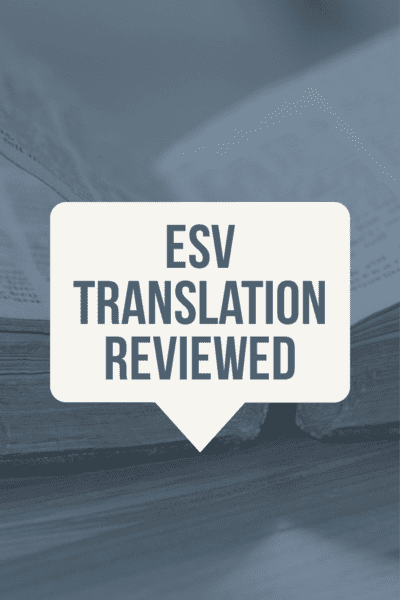
Origin: The ESV translation was first published in 2001, derived from the 1971 Revised Standard Version, taking out archaic and obsolete words. This is an “essentially literal” translation – translating the exact wording of the original languages into current literary English. It is more conservative than the New Revised Standard Version, also is a revision of the RSV.
Readability: The ESV is mostly a word for word translation, so it can sometimes be slightly awkward in wording. It is 10th grade reading level according to Bible Gateway.
Bible verse examples:
“but as he who called you is holy, you also be holy in all your conduct,” (1 Peter 1:15)
“because you have ignored all my counsel and would have none of my reproof,” (Proverbs 1:25)
So we have come to know and to believe the love that God has for us. God is love, and whoever abides in love abides in God, and God abides in him. (1 John 4:16)
“I want you to know, brothers, that what has happened to me has really served to advance the gospel,” (Philippians 1:12)
No one has ever seen God; if we love one another, God abides in us and his love is perfected in us. (1 John 4:12)
“And Ruth the Moabite said to Naomi, “Let me go to the field and glean among the ears of grain after him in whose sight I shall find favor.” And she said to her, “Go, my daughter.” (Ruth 2:2)
“He is not afraid of bad news; his heart is firm, trusting in the Lord.” (Psalm 112:7)
Target Audience: for serious Bible study, yet readable enough for daily Bible reading.
2. KJV (King James Version or Authorized Version)
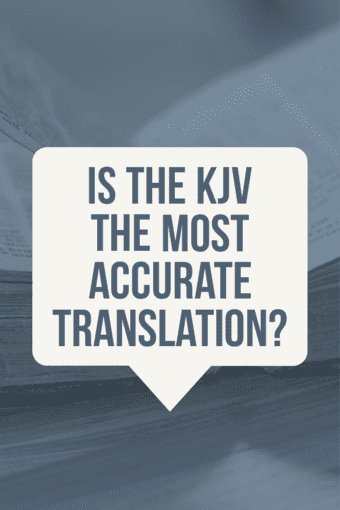
Origin: First published in 1611, translated by 50 scholars commissioned by King James I. The KJV was a revision of the Bishops Bible of 1568, also using the Geneva Bible of 1560. This translation went through major revisions in 1629 and 1638 and 1769.
Readability: loved for its beautifully poetic language; however, the archaic English can interfere with comprehension. Some idioms can be bewildering, like “her hap was to light on” (Ruth 2:3) – an archaic phrase for “she happened to come to.”
Word meanings have changed in the past 400 years. For instance, “conversation” in the 1600’s meant “behavior,” which changes the meaning of verses like 1 Peter 3:1, when the KJV says that unbelieving husbands will be won by the “conversation” of their godly wives. The KJV also has words no longer used in common English, like “chambering” (Romans 13:13), “concupiscence” (Romans 7:8), and “outwent” (Mark 6:33).
Bible verse examples:
“But as he which hath called you is holy, so be ye holy in all manner of conversation;” (1 Peter 1:15),
“But ye have set at nought all my counsel, and would none of my reproof:” (Proverbs 1:25)
“But I would ye should understand, brethren, that the things which happened unto me have fallen out rather unto the furtherance of the gospel;” (Philippians 1:12)
Target Audience: traditionalist adults who enjoy the classical elegance.
3. NIV (New International Version)
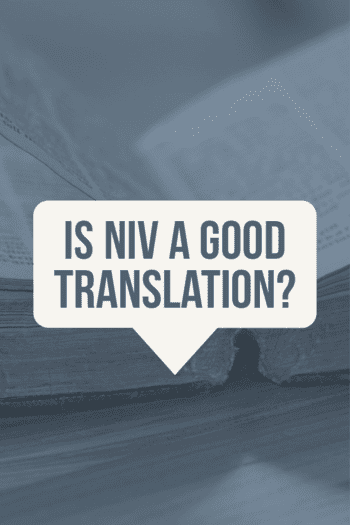
Origin: First published in 1978, this version was translated by more than 100 international scholars from thirteen denominations and five English-speaking nations. The NIV was a fresh translation, rather than a revision of a former translation. It is a “thought for thought” translation and it does omit and add words not in the original manuscripts.
Readability: considered second best for readability after the NLT, with an age 12+ reading level. A version was published in 1996 at 4th grade reading level.
Bible verse examples:
“But just as he who called you is holy, so be holy in all you do;” (1 Peter 1:15)
“since you disregard all my advice and do not accept my rebuke,” (Proverbs 1:25)
“Now I want you to know, brothers and sisters, that what has happened to me has actually served to advance the gospel.” (Philippians 1:12)
Target Audience: children, teens, and those reading through the Bible for first time.
4. NKJV (New King James Version)
Origin: first published in 1982 as a revision of the King James Version. The main objective of 130 scholars was to preserve the style and poetic beauty of the KJV, while updating grammar and vocabulary. Like the KJV, it mostly uses the Textus Receptus for the New Testament, not the older manuscripts.
Readability: much easier than the KJV, but still harder to read than most recent translations, as sentence structure can be awkward.
Bible verse examples: “but as He who called you is holy, you also be holy in all your conduct,” (1 Peter 1:15)
“Because you disdained all my counsel, And would have none of my rebuke,” (Proverbs 1:25)
“But I want you to know, brethren, that the things which happened to me have actually turned out for the furtherance of the gospel,” (Philippians 1:12)
Target Audience: teens and adults who love the poetic beauty of the KJV, but desire more understandable English.
5. NLT (New Living Translation)
Origin: published in 1996 as a revision of the 1971 Living Bible paraphrase. This was a “dynamic equivalence” (thought for thought) translation by over 90 evangelical scholars from many denominations. This translation uses gender-neutral words like “one” or “person” instead of “man” when the translators thought it was referring to people in general. As a thought for thought translation, many verses depend on the translators’ interpretation.
Readability: one of the most easily readable translations, at the junior-high reading level.
Bible verse examples:
“But now you must be holy in everything you do, just as God who chose you is holy.” (1 Peter 1:15)
“You ignored my advice and rejected the correction I offered.” (Proverbs 1:25)
“And I want you to know, my dear brothers and sisters, that everything that has happened to me here has helped to spread the Good News.” (Philippians 1:12)
Target Audience: children, young teens, and first time Bible readers.
6. NASB (New American Standard Bible)
Origin: First published in 1971, the NASB is a revision of the American Standard Version of 1901. It is a word-for-word translation – probably the most literal – by 58 evangelical scholars. This translation includes all the verses found in the KJV, but with brackets and a note for verses suspected to have been “added” to the original manuscripts. This translation was one of the first to capitalize personal pronouns related to God (He, Him, Your, etc.).
Readability: As a literal translation, the wording is slightly awkward. This translation kept the archaic “Thou,” “Thee,” and “Thy” in prayers to God, and uses a few other slightly archaic words like “behold” and phrases like “he lifted up his eyes” (instead of “he looked up”).
Bible verse examples: “but like the Holy One who called you, be holy yourselves also in all your behavior;” (1 Peter 1:15)
“And you neglected all my advice And did not want my rebuke;” (Proverbs 1:25)
“Now I want you to know, brothers and sisters, that my circumstances have turned out for the greater progress of the gospel,” (Philippians 1:12)
Target Audience: teens and adults interested in serious Bible study.
7. NET (New English Translation)
Origin: First published in 2001, the NET is a free online translation, also available in a (large, heavy) print version. Over 25 scholars translated completely from the original languages; it’s not a revision of older translations. The NET is loaded with footnotes by the translators explaining textual decisions and alternative translations, along with study notes. The NET falls in the middle ground between “word for word” and “thought for thought” translation – the text itself tends to be more thought for thought, but most verses have a footnote with a more literal, word for word translation.
Readability: The NET is easily readable (junior high reading level); however, the huge number of footnotes could be somewhat distracting if you’re simply wanting to read through a passage.
Bible verse examples: “but, like the Holy One who called you, become holy yourselves in all of your conduct,” (1 Peter 1:15)
“because you neglected all my advice, and did not comply with my rebuke,” (Proverbs 1:25)
“I want you to know, brothers and sisters, that my situation has actually turned out to advance the gospel:” (Philippians 1:12)
Target Audience: young and older teens and adults for daily reading and in-depth Bible study.
8. HCSB (Holman Christian Standard Bible)
Origin: published in 2004 and translated by 90 international and interdenominational scholars, committed to biblical inerrancy (meaning the Bible is without error), commissioned by Holman Bible Publishers. This is not a revision, but a new translation. The translators used literal word for word translation when clearly understandable, and they used thought for thought when a literal translation was awkward or unclear. If they added words to make a passage clearer, they indicated that with small brackets.
Readability: the HCSB is at an 8th grade reading level and considered easier to read when compared to other literal translations.
Bible verse examples: “But as the One who called you is holy, you also are to be holy in all your conduct;” (1 Peter 1:15)
“since you neglected all my counsel and did not accept my correction,” (Proverbs 1:25)
“Now I want you to know, brothers, that what has happened to me has actually resulted in the advance of the gospel,” (Philippians 1:12)
Target Audience: teens and adults in Bible study or devotional reading.
9. NRSV (New Revised Standard Version)
Origin: the work of 30 translators who were Protestant, Roman Catholic, Greek Orthodox, and one Jewish scholar, the NRSV is mostly a word for word (literal) translation. The NRSV was commissioned in 1974 by the National Council of Churches to update the archaic language of the Revised Standard Version and using gender-neutral words. The NRSV has a Catholic edition, which contains the Aprocrypha (a collection of books not considered to be inspired by Protestant denominations).
Readability: this version is at a high school reading level and sentence structure can be slightly odd, but generally understandable.
Bible verse examples:
“Instead, as he who called you is holy, be holy yourselves in all your conduct;” (1 Timothy 1:15)
“and because you have ignored all my counsel and would have none of my reproof,” (Proverbs 1:25)
“I want you to know, beloved,[f] that what has happened to me has actually helped to spread the gospel,” (Philippians 1:12)
Target Audience: older teens and adults from mainstream Protestant denominations as well as Roman Catholics and Greek Orthodox.
10. CSB (Christian Standard Bible)
Origin: Published in 2017, and a revision of the Holman Christian Standard Bible, the CSB was translated by 100 conservative, evangelical scholars from 17 denominations and several countries. This is an “optimal equivalence” version, meaning they tried to balance readability with precise word for word translation of the original languages.
Readability: easy to read and understand, especially for a more literal translation. Many consider it the easiest to read after the NLT and NIV versions.
The CSB has a version specifically for younger children (ages 4+): CSB Easy for Me Bible for Early Readers
Bible verse examples: “But as the one who called you is holy, you also are to be holy in all your conduct;” (1 Peter 1:15)
“since you neglected all my counsel and did not accept my correction,” (Proverbs 1:25)
“Now I want you to know, brothers and sisters, that what has happened to me has actually advanced the gospel,” (Philippians 1:12)
Target Audience: older children, teens, and adults for devotional reading, reading through the Bible, and in-depth Bible study.
11. ASV (American Standard Version)
Origin: first published in 1901, the ASV was a revision of the KJV using American English, by the American translators who worked on the Revised Version. It used the older Greek manuscripts that had recently become available, and translators omitted verses not found in the oldest manuscripts.
Readability: some but not all archaic words were updated; this version is a bit awkward to read because translators often used the sentence structure of the original language rather than standard English grammar.
Bible verse examples: “but like as he who called you is holy, be ye yourselves also holy in all manner of living;” (1 Peter 1:15)
“But ye have set at nought all my counsel, And would none of my reproof:” (Proverbs 1:25)
“Now I would have you know, brethren, that the things which happened unto me have fallen out rather unto the progress of the gospel;” (Philippians 1:12)
Target Audience: adults – especially those familiar with more archaic language.
12. AMP (Amplified Bible)
Origin: first published in 1965 as a revision of the 1901 American Standard Bible. This translation is unique in that most verses are “amplified” by including broader meanings of specific words or phrases in brackets to clarify the meaning of the verse.
Readability: It’s similar to the NASB in wording of the main text – so very slightly archaic. The brackets containing the alternate word choices or explanations can help enlighten the meaning of the verse, but at the same time be distracting.
Bible verse examples: “But like the Holy One who called you, be holy yourselves in all your conduct [be set apart from the world by your godly character and moral courage];” (1 Peter 1:15)
“And you treated all my counsel as nothing And would not accept my reprimand,” (Proverbs 1:25)
“Now I want you to know, believers, that what has happened to me [this imprisonment that was meant to stop me] has actually served to advance [the spread of] the good news [regarding salvation].” (Philippians 1:12)
Target Audience: older teens and adults desiring expanded shades of meaning of Greek and Hebrew in Bible verses.
How many Bible translations are there?
The answer depends on whether we include revisions to previous translations, but there are at least 50 translations of the full Bible into English.
Most accurate Bible translation
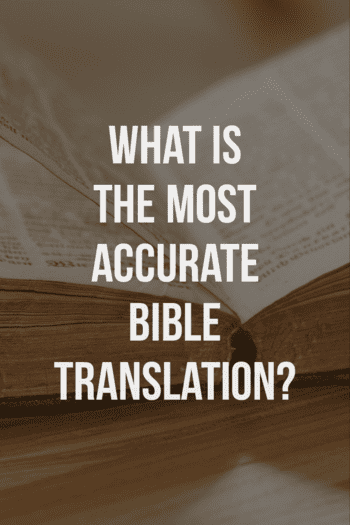
Most scholars believe the New American Standard Bible (NASB) is most accurate, followed by the English Standard Version (ESV) and the New English Translation (NET).
Translation for scholars and Bible study
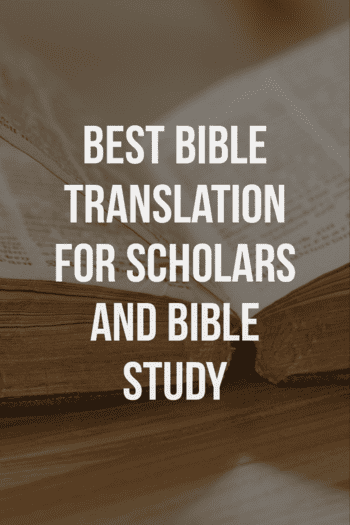
The New American Standard Bible (NASB) is the most accurate, but the Amplified Bible provides extended alternate translations, and the New English Translation (NET) is full of notes regarding translation and study helps.
What to avoid?
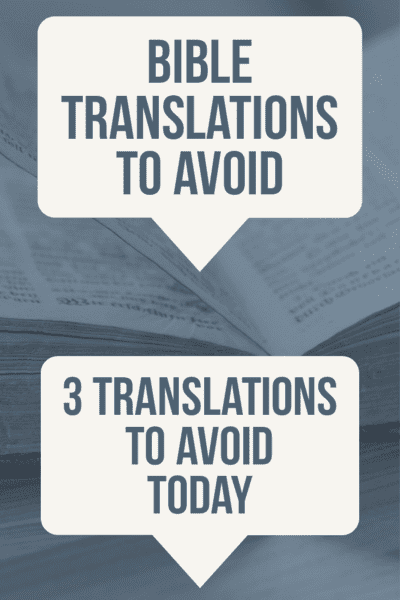
The New World Translation (NWT) is published by the Watch Tower Bible & Tract Society (Jehovah’s Witnesses). The five translators had virtually no Hebrew or Greek training. Because Jehovah’s Witnesses believe Jesus is not equal with God, they translated John 1:1 as “the Word (Jesus) was ‘a’god. John 8:58 translates Jesus as saying, “before Abraham came into existence, I have been” (rather than “I am”). In Exodus 3, God gave His name to Moses as “I am,” but because Jehovah’s Witnesses don’t believe Jesus is part of the Godhead or eternal, they changed the correct translation.
Although many Christians love The Message, an extremely loose paraphrase by Eugene Peterson, it’s so loose that it significantly changes the meaning of many verses and can be misleading.
The Passion Translation (TPT) by Brian Simmons is his attempt to include “the love language of God,” but he significantly adds to and takes away words and phrases in Bible verses, which alters the meaning of the verses.
Best for me
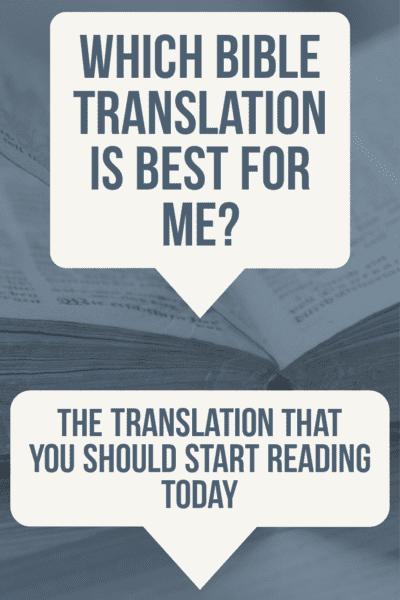
The best translation for you is the one you will read and study faithfully. Try to find a word for word (literal) translation with enough readability that you’ll stick with a daily habit of Bible reading.
If you read the Bible on your phone or device, check out Bible Hub’s parallel readings of chapters using the NIV, ESV, NASB, KJV, and HCSB in columns. This will give you a better idea of how these five popular translations vary. Also, with Bible Hub, you can read just one translation, but click on the verse number, and it will take you to a comparison of that verse in numerous translations.
Find a translation you love and let God guide and speak to you through His Word!
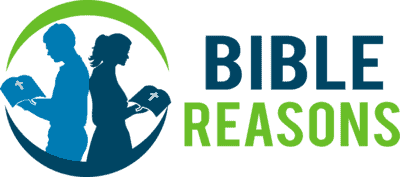
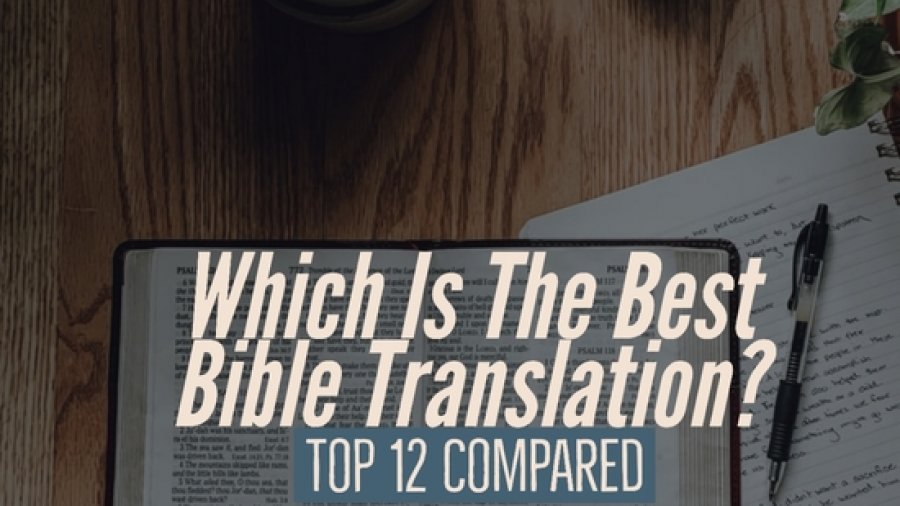
Thank you. I have just switched from NIV to NLT. The Bible is now much more readable for me.
I think the King James Version is the best Bible translation to read.
I would really love to see an ESV and AMPLIFIED BIBLE parallel bible in printed form. I’d consider that to be the ultimate study combination.